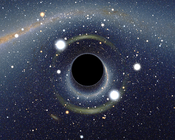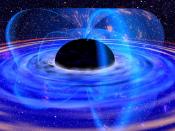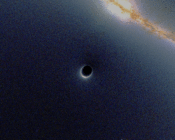BLACK HOLES
Mike Carey
Scientists have been trying to determine if black holes (earlier known as `frozen
stars') truly do exist for several decades now. Thanks to the great Albert Einstein and his
theory of relativity, researchers have been able to predict the cosmic phenomenon of black
holes. A black hole is basically an area of space that has an unbelievably high area of
concentrated mass for the space it occupies, making it impossible for an object to escape
its gravitational pull. This is due to escape velocity; the velocity required to exit an
object's gravitational pull (The Earth's escape velocity is 11.2 km/s). Because black holes
are so dense and massive the gravitational pull they possess captures light itself, making it
impossible to ever escape a black hole (for nothing as of yet is faster than the speed of
light).
Although the idea of light being trapped in such a dense object dates back to
Laplaze in the 18th century, it wasn't until Einstein developed general relativity that Karl
Schwarzschild derived a mathematical solution to describe such an object.
This lead to
further work by great minds such as Oppenheimer, Volkoff and Snyder who supported the
idea that such objects could exist in the universe. Their research led them to believe that
when a massive star runs out of fuel and is no longer able to support itself against its own
gravitational pull that it will collapse into itself to form a black hole.
Something that black holes possess due to the fact that their massiveness distorts
space and time making obsolete usual rules of geometry are `event horizons'. These can
be considered the perimeter of black holes as it marks the boundary line where the escape
velocity is equal to the speed of light. Anything inside the event...



Good job
good insite from an educational point, sounds like a lot of research was done on this topic, and its result was a really cool and interesting paper
12 out of 12 people found this comment useful.